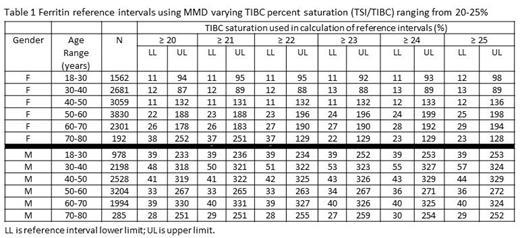Introduction
Considerable controversy has surrounded the creation of reference intervals for ferritin within tested populations. This is particularly true for women and has been attributed to a high prevalence of nonanemic iron deficiency due to physiologic blood loss during menses and physiologic iron transfer during pregnancy. The Quest Blueprint for Wellness (BFW) program is an annual health screening that provides a range of testing to Quest employees and families. Using deidentified data on 24,812 individuals (55% female; age range 18-80 years old) collected as part of this program, we studied the relationship between serum ferritin and characteristics of the study population, red blood cell parameters, and iron saturation in order to better define normal reference ranges for serum ferritin.
Methods
Test results of participants in the annual BFW screening program conducted between January 2022 and May 2023 were identified (26,535 [53% female]); tests included hematocrit, hemoglobin, RBC indices (including RDW), total serum iron and total iron binding capacity and CRP. Individuals with abnormalities of hemoglobin, hematocrit or RBC indices (including RDW); serum iron or serum TIBC; or elevated CRP were successively excluded, leaving 24,812 participants (55% female). None of these remaining individuals had a personal history of anemia or an identified ICD-10 code associated with anemia or other RBC disorder. This study population was used in subsequent analyses.
Multimodal decomposition (MMD) in R (version 4.2.2) was used to calculate reference intervals based on the distribution of results associated with the healthy study subpopulation that was defined. To address the possibility that the TIBC saturation initially employed (20%) was too low, reference intervals were also determined when varying TIBC saturations from 20%-25%.
Results
As shown in Table 1, the lower limits of the ranges identified did not vary significantly as the TIBC saturation percent was increased from 20% to 25%. The lower limit for women below 50 years of age ranged from 11-13 ng/mL, which was substantially lower than the lower limits for men of the same age.
Over the age of 50, the lower limit of the ferritin reference ranges for women increased, approaching but not equaling or exceeding the values observed for men until ages greater than 70. This may reflect the end of menses and the gradual repletion of iron stores.
In contrast, the lower limits of the reference ranges for serum ferritin for men increased at ages 30-40 and then declined and fell below that of women in the eighth decade.
Conclusions
Comparing the lower range of ferritin values between men and women, these data suggest that iron deficiency may be present in a large proportion of working age women in the absence of anemia or abnormal RBC indices. These data also suggest that normal ferritin values are age dependent for both men and women.
These conclusions are tempered by the unavailability of a physiologic reference standard able to demonstrate that iron deficiency is in fact present. The lower limit of the ferritin range for women under the age of 60 and for men over the age of 70 approximates the ferritin values associated with the absence of stainable bone marrow iron. While this test is the traditional “gold standard” it is rarely performed for the evaluation of iron status. The evaluation of iron deficiency at present lacks a physiologic indicator, analogous to the relationship between parathyroid hormone and calcium levels which permitted the definition of blood levels of 25 hydroxyvitamin D that represented sufficiency, or methylmalonic acid concentration in B12 deficiency. The broader availability of measures to assess the functional status of reticuloendothelial iron stores available to support erythropoiesis, such as measurements of hepcidin, would facilitate such an assessment.
Disclosures
Bi:Quest Diagnostics: Current Employment. Means:Affinergy Ltd: Consultancy; Pharmacosmos Therapeutics: Honoraria. Wong:Quest Diagnostics: Current Employment, Current equity holder in private company. Bare:Quest Diagnostics: Current Employment. McPhaul:Quest Diagnostics: Consultancy, Current equity holder in publicly-traded company, Ended employment in the past 24 months.


